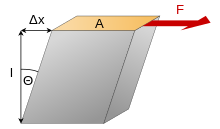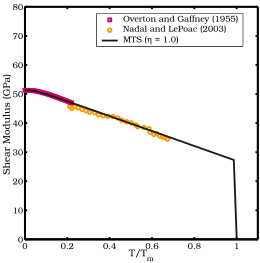| Conversion formulae
|
| Homogeneous isotropic linear elastic materials have their elastic properties uniquely determined by any two moduli among these; thus, given any two, any other of the elastic moduli can be calculated according to these formulas, provided both for 3D materials (first part of the table) and for 2D materials (second part).
|
| 3D formulae
|

|

|

|

|

|

|
Notes
|

|
|
|

|

|

|

|
|

|
|

|
|

|

|

|
|

|
|

|

|
|

|

|
|

|
|

|

|

|
|

|
|

|
|

|

|

|

|
|
|

|

|
|
|

|

|

|

|

|

|
|

|
|

|

|
|

|

|
|

|

|
|

|
|

|

|
|

|

|

|
|

There are two valid solutions.
The plus sign leads to  . .
The minus sign leads to  . .
|

|

|

|
|
|

|

|
|

|

|

|
|

|
|

|
Cannot be used when 
|

|

|

|
|

|

|
|
|

|

|

|

|
|
|

|
|

|

|

|

|
|

|
|
|

|

|

|

|

|
|
|
|
| 2D formulae
|

|

|

|

|

|

|
Notes
|

|
|
|

|

|

|

|
|

|
|

|
|

|

|

|
|

|
|

|

|
|

|

|
|

|
|

|

|

|
|

|
|

|

|
|

|
|

|

|
|

|

|
|

|

|
|

|
|

|

|

|
|
|

|

|
|

|

|

|
|

|
|

|
Cannot be used when 
|

|

|

|

|
|
|

|
|

|

|

|

|
|

|
|
|























![{\displaystyle \mu (p,T)={\frac {1}{{\mathcal {J}}\left({\hat {T}}\right)}}\left[\left(\mu _{0}+{\frac {\partial \mu }{\partial p}}{\frac {p}{\eta ^{\frac {1}{3}}}}\right)\left(1-{\hat {T}}\right)+{\frac {\rho }{Cm}}~T\right];\quad C:={\frac {\left(6\pi ^{2}\right)^{\frac {2}{3}}}{3}}f^{2}}](https://wikimedia.org/api/rest_v1/media/math/render/svg/2a44071b746c80d284fb8d0e0f1ac54b8b3e1d20)
![{\displaystyle {\mathcal {J}}({\hat {T}}):=1+\exp \left[-{\frac {1+1/\zeta }{1+\zeta /\left(1-{\hat {T}}\right)}}\right]\quad {\text{for}}\quad {\hat {T}}:={\frac {T}{T_{m}}}\in [0,6+\zeta ],}](https://wikimedia.org/api/rest_v1/media/math/render/svg/e1eaa94198fcbeba0ea126aea1b4e743ce62f1c4)























































































































































